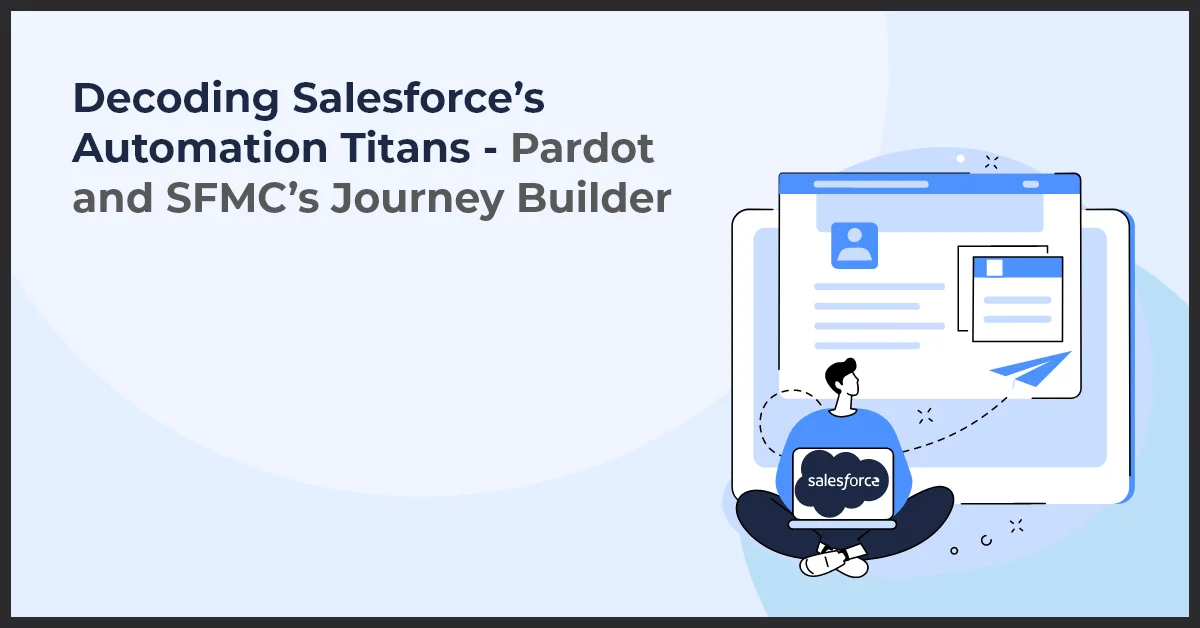Salesforce Community Cloud vs. Experience Cloud: Exploring the Best Platform for Business Success

Published on: January 3, 2024
Updated on: June 27, 2024
1482 Views
- Salesforce
12 min read
There's no tool like Salesforce when managing customer relationships and driving business growth. As a widely recognized leader in CRM software, Salesforce offers innovative solutions that empower businesses to excel in today's competitive landscape.
At its core, Salesforce is a cloud-based platform that provides businesses with a comprehensive suite of tools and features to streamline their operations, increase productivity, and enhance customer satisfaction. With its user-friendly interface and robust functionality, Salesforce has become the go-to choice for many organizations.
Two of the most sought-after offerings by Salesforce are the Community Cloud and Experience Cloud, which has given rise to the debate about which is better, the Salesforce Community Cloud vs. Experience Cloud. These clouds enable businesses to connect with their customers, partners, and employees in a new way, fostering collaboration and engagement and driving valuable insights.
Understanding Community Cloud
Building strong customer relationships is crucial for businesses to thrive in today's digitally connected world. Salesforce Community Cloud is a powerful tool that enables companies to create a customized online platform where customers, partners, and employees can connect, collaborate, and engage with each other.
Definition and Purpose of Salesforce Community Cloud
Salesforce Community Cloud is a community engagement platform that allows businesses to create branded digital spaces where employees, customers, and partners can share information, collaborate on projects, and provide feedback. It is a hub for all community-related activities, providing a personalized and immersive experience.
The purpose of Community Cloud is to empower businesses to engage with their stakeholders in a meaningful and interactive way. By facilitating communication and collaboration, Community Cloud nurtures a sense of belonging and fosters a strong community of users.
Key features and capabilities of Community Cloud
Community Cloud offers many features and capabilities that enable businesses to create vibrant, engaging, and productive online communities.
Some key features and capabilities of Community Cloud include:
- Branding and customization: Businesses can personalize their community’s look and feel, aligning it with their brand and values.
- Content management: Users can easily create, publish, and manage various types of content, including articles, blogs, videos, and discussions.
- Collaboration tools: Community members can collaborate on projects, share files, and discuss using various collaboration tools.
- Personalization: Community Cloud allows businesses to provide personalized experiences based on their community members' roles, interests, and preferences.
- Integration: Community Cloud seamlessly integrates with other Salesforce products and third-party apps, enabling businesses to leverage their existing systems.
Benefits of using Community Cloud for businesses
Implementing Salesforce Community Cloud offers several benefits for businesses, which can enhance customer engagement, streamline support processes, and drive overall growth.
Some notable benefits of using Community Cloud are:
- Enhanced customer engagement and collaboration: Community Cloud facilitates two-way communication between businesses and customers, allowing them to engage in discussions, provide feedback, and contribute to the community.
- Self-service portals for customers: Businesses can create self-service portals where customers can find answers to their questions, access resources, and troubleshoot issues independently, reducing the workload on customer support teams.
- Improved customer support and experience: Community Cloud empowers businesses to provide quick and personalized customer support, reducing response times and improving overall customer satisfaction.
Exploring Experience Cloud
Definition and Purpose of Salesforce Experience Cloud
Salesforce Experience Cloud, formerly known as Salesforce Communities, is a platform that allows businesses to build branded online communities for their customers, partners, and employees. It offers seamless user experiences by providing a single access point to all relevant information, tools, and resources.
Key features and capabilities of Experience Cloud
The Experience Cloud has various features and capabilities that help businesses create engaging and personalized user experiences.
Some of the key features include:
- Customization: The platform allows businesses to customize the look and feel of their communities to align with their brand identity.
- Collaboration: Users can collaborate and interact with each other, fostering an environment of knowledge sharing and engagement.
- Content Management: Experience Cloud enables businesses to create and manage content, including articles, videos, and FAQs, to provide valuable information to their users.
- Mobile-Optimized: The platform is mobile-responsive, ensuring seamless user experiences accessing the community on mobile devices.
Benefits of using Experience Cloud for businesses
Implementing Salesforce Experience Cloud can bring several benefits to businesses, including:
- Streamlined customer experiences across channels: Experience Cloud enables businesses to provide a consistent and seamless experience to their customers across multiple channels, such as web, mobile, and social media.
- Personalization and customization options: The platform allows businesses to personalize the user experience by delivering targeted content and recommendations based on individual preferences and behavior.
- Enhanced digital transformation and customer engagement: Experience Cloud facilitates digital transformation by enabling businesses to interact and engage with their customers meaningfully and personally.
Comparison: Salesforce Community Cloud vs. Experience Cloud
When choosing the right cloud solution for your business, understanding the differences between Salesforce Community Cloud vs. Experience Cloud is crucial. While both platforms offer unique features and capabilities, they serve different purposes and cater to different use cases.
Differentiating factors between Salesforce Community Cloud vs. Experience Cloud
One of the main differentiating factors between Salesforce Community Cloud vs. Experience Cloud is their target audience. Community Cloud is designed for building online communities and networks where customers, partners, and employees can collaborate and engage. On the other hand, Experience Cloud focuses on delivering personalized and branded experiences to external users.
Community Cloud offers robust community management tools, allowing businesses to easily create and manage custom communities. Experience Cloud, on the other hand, revolves around customer and partner portals, providing users with self-service tools, knowledge bases, and personalized content.
Key similarities and overlaps between the two platforms
Although Community Cloud and Experience Cloud have distinct purposes, there are areas where they overlap and provide similar functionalities:
- Customization and branding: Both platforms allow businesses to customize their communities' or portals' look and feel, ensuring brand consistency and a tailored user experience.
- Engagement and collaboration: Whether through communities or portals, both platforms foster engagement and collaboration among users, driving knowledge-sharing and relationship-building.
- Data and analytics: Community Cloud and Experience Cloud provide powerful analytics tools to track user behavior, measure engagement, and gain insights for improved decision-making.
Choosing the Right Solution for Your Business
Several factors must be considered when choosing between Salesforce Community Cloud vs. Experience Cloud. You can make an informed decision by evaluating your business needs and objectives, identifying your target audience and user requirements, and considering the following factors.
- Customization: Determine how much customization you require for your community or portal. Community Cloud provides robust customization options, allowing you to tailor the user experience to your needs. On the other hand, Experience Cloud offers pre-built templates and components that may be more suitable for businesses looking for a streamlined setup.
- Integration: Consider the systems and tools your business already uses. Community Cloud offers seamless integration with other Salesforce products, such as Sales Cloud and Service Cloud, making it an ideal choice for businesses that rely heavily on Salesforce's ecosystem. Experience Cloud, on the other hand, provides integration capabilities with external systems and can be easily connected to your existing infrastructure.
- Security: If data security is paramount to your business, Community Cloud and Experience Cloud offer robust security features. However, Community Cloud provides more granular control over user access and permissions, making it a preferred choice for businesses with strict security requirements.
- Scalability: Consider the future growth of your business. Community Cloud and Experience Cloud can accommodate growing user bases, but Community Cloud's flexible architecture allows for more scalability and customization as your community or portal expands.
Additionally, it's essential to examine case studies and success stories of businesses that have contemplated the practical implications of Salesforce Community Cloud vs. Experience Cloud. These real-world examples can provide valuable insights into how each solution has addressed similar business needs and requirements.
Implementation and Best Practices
Key steps for implementing Community Cloud
Implementing Salesforce Community Cloud requires careful planning and execution.
Here are the key steps to follow:
- Define your community's objectives: Clearly outline the purpose and goals of your community to ensure alignment with your business objectives.
- Select the appropriate template: Choose a pre-built template or create a custom one that best suits your community's needs.
- Design the user interface: Create a visually appealing and intuitive interface that encourages member participation and engagement.
- Configure community settings: Customize various settings, such as navigation, branding, and security, to align with your organization's requirements.
- Create and manage member profiles: Determine the information you want to collect from members and set up profile fields accordingly.
- Set up community groups: Organize members into relevant groups for targeted communication and collaboration.
- Enable features and functionality: Select and configure community features such as discussions, knowledge sharing, and document collaboration based on your business needs.
- Integrate with other systems: Seamlessly integrate Community Cloud with other Salesforce solutions and external systems for enhanced functionality.
- Train administrators and moderators: Provide comprehensive training to ensure administrators and moderators are proficient in managing and supporting the community.
- Launch and promote your community: Develop a launch strategy and execute it to generate excitement and drive member adoption.
Important considerations for Experience Cloud implementation
Implementing Salesforce Experience Cloud requires attention to specific considerations to ensure a successful implementation.
Here are some important factors to keep in mind:
- Define your target audience: Identify the audience you want to engage through your Experience Cloud to tailor the experience accordingly.
- Choose the right components: Select and configure the appropriate components to deliver the desired functionality and user experience.
- Customize the user interface: Design a user-friendly interface that aligns with your brand and ensures seamless navigation for your audience.
- Configure access and security: Determine the access levels and security measures required to protect sensitive data while enabling collaboration.
- Integrate with external systems: Integrate Experience Cloud with other systems to provide a unified experience and streamline workflows.
- Implement personalization: Leverage personalization options to deliver tailored content and recommendations to individual users.
- Enable analytics and reporting: Set up analytics and reporting capabilities to track user engagement and measure the success of your Experience Cloud.
- Monitor and optimize performance: Regularly monitor the performance of your Experience Cloud and make necessary optimizations to ensure optimal user experience.
- Train and support community managers: Provide comprehensive training and ongoing support to community managers to manage the Experience Cloud effectively.
- Continuously gather feedback: Collect feedback from users to identify areas for improvement and enhance the overall experience.
Tips for driving user adoption and engagement
Meanwhile, being in the debate between Salesforce Community Cloud vs. Experience Cloud, if you want to achieve high user adoption and engagement, consider the following tips:
- Communicate the value: Highlight the benefits and advantages of participating in the community or accessing the Experience Cloud.
- Promote user benefits: Emphasize how members can connect, collaborate, and learn from each other, fostering professional growth and problem-solving.
- Provide comprehensive onboarding: Offer onboarding materials and resources to help new members navigate the community or Experience Cloud effectively.
- Encourage active participation: Respond to member questions and facilitate discussions to encourage engagement and knowledge sharing.
- Incentivize contributions: Recognize and reward members who actively contribute valuable content, fostering a sense of community ownership.
- Facilitate networking: Create opportunities for members to connect with peers, experts, and mentors within the community.
- Offer exclusive content: Provide exclusive resources, insights, or events to incentivize user activity and engagement.
- Regularly communicate updates and news: Keep members informed about new features, events, and relevant updates through newsletters or announcements.
- Organize virtual events and webinars: Host virtual events and webinars to provide educational content and foster real-time interaction.
- Monitor and respond to feedback: Actively listen to member feedback, address concerns, and make improvements based on their input.
Conclusion
Choosing the right cloud solution for your business is a crucial decision that can greatly impact your customer experiences and overall growth. In this article, we have explored the key differences between Salesforce Community Cloud vs. Experience Cloud and discussed the benefits offered by each platform.
Recap of the key differences between Salesforce Community Cloud vs. Experience Cloud
- Community Cloud focuses on creating a collaborative user portal where customers, partners, and employees can interact and engage.
- Experience Cloud, on the other hand, provides a personalized and interactive website experience for external users.
Summary of benefits offered by each platform
- Community Cloud fosters better collaboration and knowledge sharing among the community members, improving customer support and loyalty.
- Experience Cloud enables businesses to deliver tailored experiences to their external users, enhancing customer engagement and satisfaction.
Final thoughts on selecting the most suitable solution for businesses
When it comes to selecting between Community Cloud and Experience Cloud, it ultimately depends on your specific business needs and goals. Consider factors such as the nature of your customer interactions and the level of personalization required.
Community Cloud may be ideal for businesses to create a thriving community and foster collaboration. On the other hand, if your focus is on delivering personalized website experiences to your external users, Experience Cloud can provide the necessary tools and capabilities.
Importance of Salesforce in driving customer experiences and business growth
Regardless of your chosen cloud solution, Salesforce is crucial in driving customer experiences and business growth. With its comprehensive suite of tools and features, Salesforce empowers businesses to understand their customers better, personalize interactions, and ultimately drive success.
By leveraging Salesforce, businesses can tap into data-driven insights, automation, and seamless integrations to deliver exceptional customer experiences, improve operational efficiency, and fuel growth.
Frequently Asked Questions
While Salesforce Community Cloud primarily focuses on building online communities, Experience Cloud offers a broader range of capabilities for creating and managing digital experiences, including portals, websites, forums, self-service portals, mobile apps, and more. Experience Cloud also integrates with Salesforce’s broader suite of products for enhanced functionality and customization.
Experience Cloud expands upon the capabilities of Salesforce Community Cloud by offering tools for building a wider range of digital experiences, such as customer portals, self-service websites, mobile apps, web forums, e-commerce platforms, and more. It provides greater flexibility, customization, and scalability to meet diverse business needs.
Both Salesforce Community Cloud and Experience Cloud can benefit businesses of all sizes and industries, particularly those looking to improve customer engagement, streamline partner relationships, empower employees, and deliver personalized digital experiences across various touchpoints.
Salesforce Community Cloud or Experience Cloud improves customer engagement by providing a centralized platform for customers to access resources, seek support, interact with peers and experts, participate in discussions, provide feedback, and stay informed about products and services, fostering a sense of community and connection with the brand.
Salesforce Community Cloud or Experience Cloud solutions are highly customizable, allowing businesses to tailor their communities and digital experiences to their specific branding, design, functionality, and integration requirements. They offer a range of customization options, including templates, themes, branding elements, layout tools, and developer resources.



